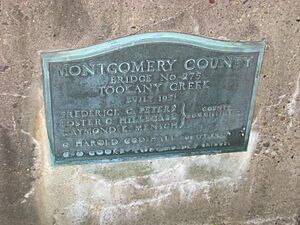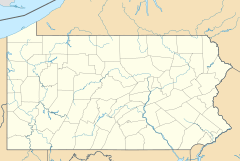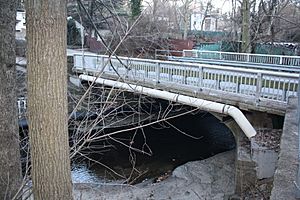Frankford Creek facts for kids
Quick facts for kids Frankford Creek |
|
|---|---|

Tookany Creek in Cheltenham Township
|
|
|
Location of the Creek in Pennsylvania
|
|
| Other name(s) | Tookany Creek, Tacony Creek |
| Country | United States |
| State | Pennsylvania |
| Region | Delaware Valley |
| District | Montgomery County and Philadelphia County |
| Municipality | Cheltenham Township and City of Philadelphia |
| Physical characteristics | |
| Main source | Hill Crest Cheltenham |
| River mouth | Delaware River Bridesburg/Port Richmond 39°59′7.5372″N 75°4′15.2394″W / 39.985427000°N 75.070899833°W |
| Basin features | |
| River system | Delaware River |
Frankford Creek is a small river, also called a tributary, that flows into the Delaware River in southeastern Pennsylvania. It gets its name from the nearby town of Frankford, Philadelphia.
The creek starts as Tookany Creek in Cheltenham Township. It winds its way through Cheltenham and then turns into Tacony Creek near the Philadelphia border. From here, it forms an unofficial boundary for Northeast Philadelphia. Neighborhoods like Olney and Feltonville are on one side, while Lawncrest and Frankford are on the other.
Later, a smaller creek called Wingohocking Creek joins it. After this, the creek becomes known as Frankford Creek. It flows until it meets the Delaware River in the Bridesburg neighborhood. The Frankford Creek part is about 3.1 miles (5 km) long. The upstream section, Tacony Creek, is about 11.1 miles (17.9 km) long.
The Lenni Lenape Native Americans, who lived here long ago, called the creek Quessionwonmink. This name means "Eel Skin River." Some people think the name Tacony comes from a Lenni Lenape word meaning "forest" or "wilderness."
Contents
How Frankford Creek Has Changed
Over the years, parts of Frankford Creek and its smaller streams have been changed. This was done to manage water flow and make space for city growth.
Creek Diversions and Sewers
- Wingohocking Creek was partly turned into underground sewers between 1905 and 1915. This helped manage stormwater in the growing city.
- In 1934, a sharp bend in the creek was removed. A new, straight channel was dug to help the water flow better.
- More changes happened in 1949 when two more bends were straightened. You can still see parts of an old bridge from this time.
- In 1956, the creek's path was changed again. It was moved to meet the Delaware River at a different spot. This helped with development around the Frankford Arsenal.
- Today, much of Frankford Creek flows through underground storm sewers. This helps control flooding in urban areas. You can see how much it has changed on this map.
Historic Bridges Over the Creek
Many old and important bridges cross Frankford, Tacony, and Tookany Creeks. These bridges show how people traveled and built roads in the past.

- Fisher's Lane Bridge: This stone arch bridge was built in 1796. It carries Fisher's Lane over Tacony Creek in Philadelphia.
- Adams Avenue Bridge: Built in 1901, this stone arch bridge crosses Tacony Creek in Philadelphia's Tacony Creek Park. It is listed on the National Register of Historic Places, meaning it's an important historical site.
- Roosevelt Boulevard Bridge: A concrete arch bridge built in 1909. It carries Roosevelt Boulevard (US Route 1) over Tacony Creek.
- Wyoming Avenue Bridges: Two concrete arch bridges built in 1909. They cross the old path of Frankford Creek in Philadelphia.
- Church Road Bridge: A concrete arch bridge built in 1930. It carries Church Road (PA Route 2023) over Tookany Creek in Montgomery County.
- Mill Road Bridge: Another concrete arch bridge from 1930. It carries Mill Road over Tookany Creek, also in Montgomery County.
What's in a Name?
The different names of Frankford Creek and its branches have interesting histories. Many come from the Lenni Lenape language.
Wingohocking Creek's Name
Wingohocking Creek is one of the streams that forms Frankford Creek.
- It was called Winconico and Wincokoe in old documents.
- The name Wingohocking might mean "a good place for farming" or "lands in a valley."
- In more recent times, it was called "Logan's Run." This was because it flowed through the land of James Logan, an important statesman.
- Wingohocking Creek starts near Mount Airy. It flows south and then east to join Tacony Creek.
Tookany Creek's Name
Tookany Creek starts in Montgomery County.
- It flows southwest and south, forming a boundary between old townships.
- Rock Run is a smaller stream that flows into Tookany Creek.
Other Names and Meanings
- The stream now called Frankford Creek starts where Tacony and Wingohocking creeks meet. It flows into the Delaware River near the U.S. Arsenal.
- Tacony was called Taoconik and Toaconinck in old records from the 1680s.
- The name Tacony might come from Tekene, meaning "woods" or "an uninhabited place."
- Another stream, Freaheatah, flows into Frankford Creek near the Delaware.
- On an old map by Lindstrom, Frankford Creek was called "Aleskins Kylen." This means "the river of skinned eels" in French. The reason for this name is not fully known.
- Parts of the creek were also called Questioninck and Quissinuaminck in old documents.
Community Connection
Frankford Creek is very important to the communities of Cheltenham and North Philadelphia.
- It has given many local children their first chance to learn about nature and ecosystems.
- The creek has also inspired many community projects.
- Several parks were created along its banks, including Wall Park and High School Park in Cheltenham. In Philadelphia, there are Olney Park, Juniata Park, and Womrath Park.
- The area around the creek is one of the few urban meadows in Philadelphia. These are important natural spaces in the city.
- Cobbs Creek has a similar positive impact on children in West Philadelphia and Upper Darby.



